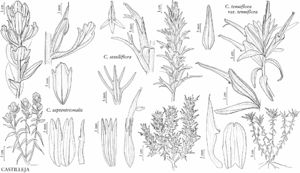Difference between revisions of "Castilleja tenuiflora var. tenuiflora"
FNA>Volume Importer |
FNA>Volume Importer |
||
| Line 7: | Line 7: | ||
|name=Castilleja laxa | |name=Castilleja laxa | ||
|authority=A. Gray | |authority=A. Gray | ||
| − | }}{{Treatment/ID/Synonym | + | }} {{Treatment/ID/Synonym |
|name=C. setosa | |name=C. setosa | ||
|authority=Pennell | |authority=Pennell | ||
| Line 25: | Line 25: | ||
|elevation=700–2500 m. | |elevation=700–2500 m. | ||
|distribution=Ariz.;N.Mex.;Mexico. | |distribution=Ariz.;N.Mex.;Mexico. | ||
| − | |discussion=<p>Variety tenuiflora is fairly common in the southern Sky Island ranges of southeastern Arizona and occurs in the Animas Mountains of Hidalgo County, southwestern New Mexico. It is also found throughout much of Mexico, where it is the most common species of Castilleja.</p> | + | |discussion=<p>Variety tenuiflora is fairly common in the southern Sky Island ranges of southeastern Arizona and occurs in the Animas Mountains of Hidalgo County, southwestern New Mexico. It is also found throughout much of Mexico, where it is the most common species of <i>Castilleja</i>.</p> |
|tables= | |tables= | ||
|references= | |references= | ||
| Line 49: | Line 49: | ||
|publication year= | |publication year= | ||
|special status= | |special status= | ||
| − | |source xml=https://jpend@bitbucket.org/aafc-mbb/fna-data-curation.git/src/ | + | |source xml=https://jpend@bitbucket.org/aafc-mbb/fna-data-curation.git/src/8f726806613d60c220dc4493de13607dd3150896/coarse_grained_fna_xml/V17/V17_1176.xml |
|genus=Castilleja | |genus=Castilleja | ||
|species=Castilleja tenuiflora | |species=Castilleja tenuiflora | ||
Revision as of 14:56, 18 September 2019
Herbs or subshrubs, perennial, 1.8–6 dm; from a woody caudex; with a taproot. Stems few to many, erect or ascending, unbranched, sometimes branched, hairs dense, spreading to ±reflexed, short, ± stiff, eglandular. Leaves erect to ± reflexed, green to sometimes purple, lanceolate to linear-lanceolate, 2–3(–4) cm, not fleshy, margins plane, flat to slightly involute, 0(–3)-lobed, apex acute to acuminate; lobes spreading, linear, narrowly triangular, short, apex acute. Inflorescences 3–11 × (2.5–)5–7 cm; bracts red or green throughout, rarely light orange or light yellow throughout, or proximally greenish, distally colored as above, less showy than calyces, lanceolate, 0(–3)-lobed; lobes erect, linear or lanceolate-acuminate, short, arising near apex, apex acute. Calyces entirely red or proximally green, distally red, light orange, or light yellow, 27–35(–40) mm; abaxial clefts 12–18 mm, adaxial 8–14 mm, abaxial 55–60% of calyx length, adaxial 20–35% of calyx length, deeper than laterals, lateral 0(–2.5) mm, 0(–7)% of calyx length; lobes linear to lanceolate to broadly triangular, apex rounded to emarginate or acute. Corollas straight or slightly curved, 36–47 mm; tube 18–25 mm; abaxial lip often exserted, beak exserted; beak adaxially whitish, yellow to green, or reddish, 15–26(–30) mm; abaxial lip green to yellow or white, reduced, protruding through abaxial cleft, 1–2 mm, ca. 8% as long as beak; teeth incurved, white or deep green, 0.5–1 mm. 2n = 24, 48.
Phenology: Flowering Mar–Nov(–Dec).
Habitat: Open pine-oak woodlands, rocky slopes, ledges, chaparral, quartzite and other bedrock types.
Elevation: 700–2500 m.
Distribution
Ariz., N.Mex., Mexico.
Discussion
Variety tenuiflora is fairly common in the southern Sky Island ranges of southeastern Arizona and occurs in the Animas Mountains of Hidalgo County, southwestern New Mexico. It is also found throughout much of Mexico, where it is the most common species of Castilleja.
Selected References
None.
